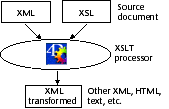4D v13.4
Overview of XML Utilities Commands
- 4D Language Reference
-
- XML
-
- Overview of XML Utilities Commands
- XML DECODE
- XML GET ERROR
- XML GET OPTIONS
- XML SET OPTIONS
- XSLT APPLY TRANSFORMATION
- XSLT GET ERROR
- XSLT SET PARAMETER
 Overview of XML Utilities Commands
Overview of XML Utilities Commands
This theme groups together the generic XML "utilities" commands of 4D. These are option- and error-management commands as well as commands specialized in XSL.
For general information about XML (overview, glossary) as well as the differences between DOM and SAX modes, please refer to the Overview of XML DOM Commands section.
4D supports the application of XSL style sheets (eXtended Stylesheet Language). The XSL language allows you to modify the tags of an XML document.
The XSL language features two different aspects:
- Formatting: It allows you to apply style and display rules to XML elements, similar to CSS (Cascading StyleSheet) in HTML.
- Transformations: It allows you to change XML tags to a different tag system, for example, HTML. This function is known as XSLT. An XSL style sheet can totally reorganize the XML elements of a document by selecting them then transforming them into other elements. This function is useful, for example, for synchronizing a set of dissimilar documents.

Note: 4D uses the Xalan-C_1_6_0.dll library to perform XSL transformations. Xalan is a freeware XSLT processor. For more information, please visit http://xml.apache.org/xalan-c/index.html.
XSL style sheets are text documents (with .xsl extensions) generated manually or using specialized applications. The XSL language features various elements and functions that allow you to perform any type of dynamic transformation. For more information on this language, please visit http://xmlfr.org (for example).
4D allows you to transform an XML document using an existing XSL style sheet (XSLT APPLY TRANSFORMATION command). Also, 4D allows you to modify XSL style sheet parameters on the fly using the XSLT SET PARAMETER command.
Note: An option in the export dialog box lets you use an XSL style sheet when exporting XML and thus generate a transformed XML document.
SVG (Scalable Vector Graphics) is a file format used to describe vector graphics (extension .svg) in XML. The most common use of SVG is the publication of statistical or mapping data.
These files can be viewed in Web browsers either natively, or via plug-ins. 4D v11 includes an SVG rendering engine that lets you view SVG files in picture fields or variables. The SVG EXPORT TO PICTURE command
can be used to generate a picture in 4D based on an SVG description. Also note that the GRAPH command can be used to take advantage of the integrated SVG engine of 4D.
For more information about this format, please refer to the following address: http://www.w3.org/Graphics/SVG/.
Product: 4D
Theme: XML







